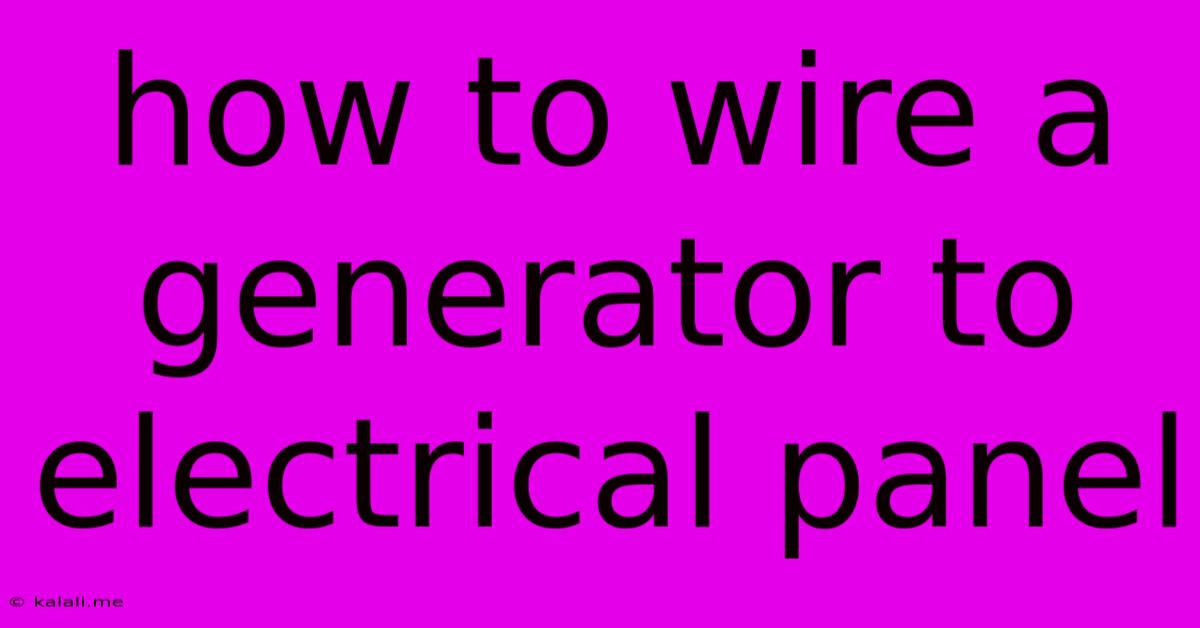How To Wire A Generator To Electrical Panel
Kalali
May 30, 2025 · 4 min read

Table of Contents
How to Wire a Generator to Your Electrical Panel: A Comprehensive Guide
Meta Description: Learn how to safely and correctly wire a generator to your electrical panel for reliable backup power during outages. This comprehensive guide covers essential steps, safety precautions, and crucial considerations.
Power outages can be disruptive and inconvenient, but a properly installed generator can provide peace of mind and keep essential systems running. This guide details how to wire a generator to your electrical panel, offering a step-by-step process focusing on safety and best practices. However, this guide is for informational purposes only. For professional installation, always consult a licensed electrician. Improper wiring can lead to serious injury or damage.
Understanding the Interconnect System: The Heart of Backup Power
Wiring a generator to your electrical panel requires an interconnect system, often a transfer switch. This crucial component prevents backfeeding power to the grid, protecting utility workers and your property. There are two main types:
- Manual Transfer Switches: These require manual switching between utility power and generator power. They're less expensive but require you to physically switch the power source.
- Automatic Transfer Switches (ATS): These automatically switch to generator power during an outage and back to utility power when it's restored. They are more expensive but offer greater convenience and safety.
Essential Tools and Materials
Before you begin, gather these necessary items:
- Generator: Choose a generator with sufficient wattage to power your essential appliances and systems.
- Transfer Switch (Manual or Automatic): Sized appropriately for your generator's output.
- Heavy-duty extension cords: Rated for the generator's amperage.
- Wire strippers and crimpers: For preparing and connecting wires.
- Wire nuts: For secure wire connections.
- Voltage tester: To verify power and ensure safety.
- Circuit breaker: If installing a manual transfer switch, ensure the breaker is rated for the generator’s amperage.
- Appropriate gauge wiring: The correct gauge depends on the amperage of your generator. Consult an electrician or the generator manual for specifics.
- Safety glasses and gloves: Essential for protecting yourself from potential hazards.
Step-by-Step Wiring Process (General Overview – Consult Your Specific Equipment Manuals)
This is a simplified overview; always consult your generator and transfer switch manuals for specific instructions.
- Disconnect Main Power: Turn off the main breaker at your electrical panel. Verify power is off using a voltage tester.
- Install the Transfer Switch: This is often a complex task and may require professional help. The switch will be installed in your electrical panel.
- Wire the Generator to the Transfer Switch: Connect the generator's output wires to the appropriate terminals on the transfer switch. Use the correct gauge wiring and secure connections with wire nuts.
- Wire the Transfer Switch to the Electrical Panel: Carefully connect the transfer switch to the designated circuits in your electrical panel. This usually involves connecting wires to specific bus bars.
- Connect Grounding Wires: Proper grounding is crucial for safety. Ensure all grounding wires are correctly connected to the generator, transfer switch, and electrical panel.
- Test the System: Carefully switch the transfer switch to the generator position. Turn on the generator and verify power is flowing to the designated circuits.
- Test Functionality: Turn on your essential appliances and systems to ensure the generator is functioning correctly.
Safety Precautions: Prioritizing Safety Above All Else
- Never work on electrical systems while the power is on. Always disconnect the main power before starting any work.
- Use appropriate safety equipment, including safety glasses and gloves.
- Understand the electrical system in your home. If you are not comfortable working with electricity, hire a licensed electrician.
- Never attempt to backfeed power to the grid. This is extremely dangerous and can result in serious injury or death.
- Consult your local building codes and regulations. These may dictate specific requirements for generator installation.
- Regularly inspect and maintain your generator and interconnect system.
Choosing the Right Generator Size: Avoiding Overloading
The size of your generator is crucial. It should provide enough power for all your essential appliances and systems. Consider the wattage of each device and add a safety margin. An overloaded generator can overheat and fail.
This guide offers a general overview. Professional installation by a qualified electrician is always recommended. They can ensure the system is correctly installed, safely wired, and meets all local codes. Proper installation ensures your backup power system is safe, reliable, and ready when you need it most.
Latest Posts
Latest Posts
-
Good How About You In Spanish
May 31, 2025
-
How Long Is Sour Cream Good After The Expiration Date
May 31, 2025
-
Where Did My Notes Go On My Mac Mojave
May 31, 2025
-
Manually Add Default Gateway To Centos 6
May 31, 2025
-
How To Light A Hot Water Tank
May 31, 2025
Related Post
Thank you for visiting our website which covers about How To Wire A Generator To Electrical Panel . We hope the information provided has been useful to you. Feel free to contact us if you have any questions or need further assistance. See you next time and don't miss to bookmark.